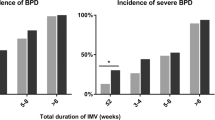Abstract
OBJECTIVE: To compare a 4-day course of antibiotic therapy to a 7-day course in selected term and near-term neonates with pneumonia.
METHODS: The diagnosis of pneumonia was made in neonates admitted to the normal Newborn Nursery (NBN) who later had signs of respiratory distress and whose chest radiographs were consistent with pneumonia. Infants were excluded if any of the following was present: moderate or thick meconium-stained amniotic fluid, prior antibiotic therapy >24 hours, or need for supplemental oxygen >8 hours. Infants who were asymptomatic after 48 hours of antibiotic therapy were prospectively randomized to a 4-day group (n=35) or a 7-day group (n=38). Infants in the 4-day group were observed in the hospital for 24 hours following cessation of antibiotics and were seen in follow up within several days of discharge.
RESULTS: The groups were comparable with regard to demographic factors, duration of rupture of membranes, and incidence of maternal chorioamnionitis. Median postnatal age at the time of identification of respiratory distress symptomatology was 19 hours (range 0.5 to 55 hours) in the 4-day group and 12 hours (range 1 to 72 hours) in the 7-day group. No study infants had a positive blood culture. Mean reduction in length of hospitalization was 2.1 days, with estimated savings of greater than US$700 per shortened hospitalization. Two infants in the 4-day group developed tachypnea during the 24-hour observation period. However, no infants were rehospitalized for sepsis or pneumonia following discharge. With 95% confidence, the true rate of success for the 4-day group was at least 92%.
CONCLUSION: Four days of antibiotic therapy plus a 24-hour period of observation for selected cases of neonatal pneumonia appears to be comparable to 7 days of therapy. It is important to note that newborns in our institution receive a single dose of penicillin soon after birth as part of our group B streptococcal sepsis prophylaxis program, and all infants in this study received prophylaxis prior to the onset of respiratory symptoms. Furthermore, only infants who were asymptomatic after 48 hours of antibiotic therapy were included in this study, and a 24-hour observation period at the end of the 4-day course was required. These qualifications should be taken into account before use of this approach is considered, and additional studies are necessary to further establish its safety and benefits.
This is a preview of subscription content, access via your institution
Access options
Subscribe to this journal
Receive 12 print issues and online access
$259.00 per year
only $21.58 per issue
Buy this article
- Purchase on Springer Link
- Instant access to full article PDF
Prices may be subject to local taxes which are calculated during checkout
Similar content being viewed by others
Author information
Authors and Affiliations
Rights and permissions
About this article
Cite this article
Engle, W., Jackson, G., Sendelbach, D. et al. Neonatal Pneumonia: Comparison of 4 vs 7 Days of Antibiotic Therapy in Term and Near-Term Infants. J Perinatol 20, 421–426 (2000). https://doi.org/10.1038/sj.jp.7200416
Published:
Issue Date:
DOI: https://doi.org/10.1038/sj.jp.7200416
This article is cited by
-
Short-course antibiotic therapy for pneumonia in the neonatal intensive care unit
Journal of Perinatology (2023)
-
Neonatal sepsis definitions from randomised clinical trials
Pediatric Research (2023)
-
Comparison of Four Days Versus Seven Days Duration of Antibiotic Therapy for Neonatal Pneumonia: A Randomized Controlled Trial
The Indian Journal of Pediatrics (2018)
-
Can We Reduce the Duration of Antibiotic Therapy for Neonatal Pneumonia?
The Indian Journal of Pediatrics (2018)
-
Duration of antibiotic therapy for bacteremia: a systematic review and meta-analysis
Critical Care (2011)


